1914
Catherine the Great Egg
Gift
Nicholas II to Maria Feodorovna
Made in
Saint Petersburg
Owner: Hillwood
Museum, Washington, DC, USA,
The Marjorie Merriweather Post Collection
Height:
12,1 cm
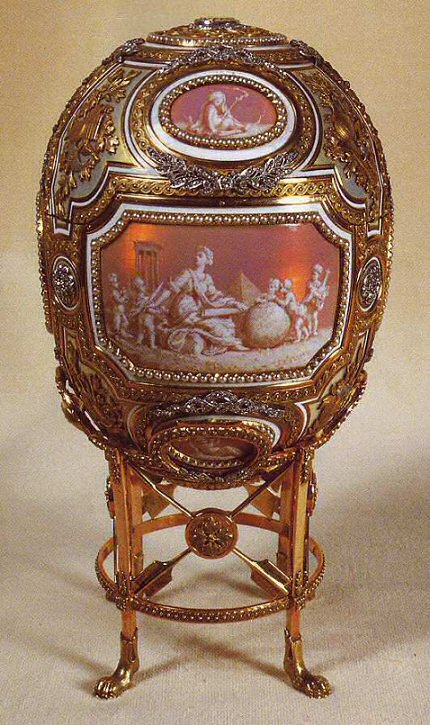
The Catherine the Great Egg, also known as Grisaille Egg, and Pink Cameo Egg, is made of quatre-couleur gold, pink grisaille and opaque white enamel, portrait diamonds, rose-cut diamonds, seed pearls and velvet lining. The Surprise (lost), a mechanical sedan chair, was made of gold, enamel and probably diamonds.
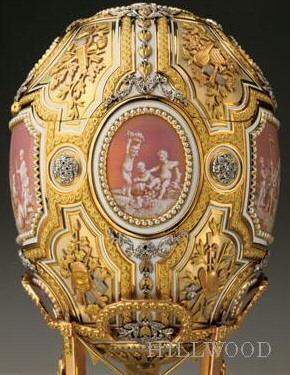
Picture courtesy Hillwood, Estate, Museum & Gardens
Henrik Wigström, Fabergé's last head work master, created this Egg for Nicholas II to present to his mother, Maria Feodorovna, on Easter morning in 1914. Vasilii Zuiev painted the two rectangular panels in "camaieu" rose enamel with miniature allegorical scenes of the arts and sciences after French artist François Boucher. According to a letter from Maria Feodorovna to her sister, Queen Alexandra of England, the surprise in this Egg was a mechanical sedan chair, carried by two blackamoors, with Catherine the Great seated inside. To feature Catherine the Great, who prided herself on being a patron of the arts and sciences, as part of the surprise is certainly in keeping with this elaborate Egg's style and imagery.
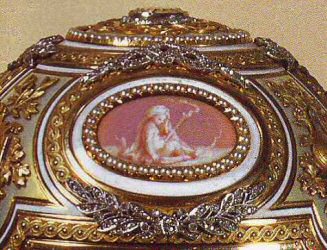
Background information
This Egg may best represent the height of Fabergé's career, expressions in miniature of the life of Imperial privilege. It was kept at Maria's favorite Anichkov Palace and it was inspired by the opulent embellishments of the palace interior, where many of the ceilings are painted en grisaille. According to the letter from Maria Feodorovna to her sister, Queen Alexandra of England, the surprise was incredibly beautiful: "Mr. Fabergé himself has brought me this most beautiful egg. Inside is a sedan chair carried by two blackamoors with Catherine the Great in it, wearing a little crown on her head. You wind it up and then the blackamoors walk: it is an unbelievably beautiful and superbly fine piece of work. Fabergé is the greatest genius of our time. I also told him: "Vous êtes un génie incomparable" (you are a genius beyond compare).
By the time Armand Hammer acquired the Egg in 1930 from the Antikvariat, the surprise had been lost. The "sedan chair" on the picture seen below, is not the surprise of Catherine Egg.
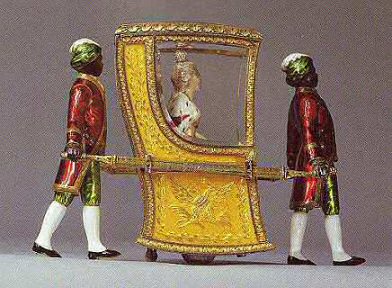
(Snowman, the Art of Karl Fabergé, 1953)
For a long time it was thought that the mechanical chair (ex Charles Clore Collection) could be the surprise from the Catherine the Great Egg. However when the Manager of the Hillwood Museum came with the Egg to the New York auction of the chair, it was a big disappointment to everyone that the surprise did not fit into the Egg en therefore was nót the long lost surprise.
In 1927 sold as one of the ten Imperial Eggs to the Hammer Galleries in New York. 1931 bought by Eleanor Barzin as birthday present for her mother, Marjorie Merriweather Post. 1973 Collection of the late Marjorie Merriweather Post, willed to the Hillwood Museum, Washington, D.C., United States.
The stand to the Egg is not original. On the image below you can see the Egg as it was advertised by Armand Hammer in the 1930's.
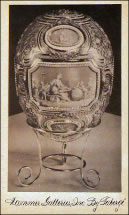
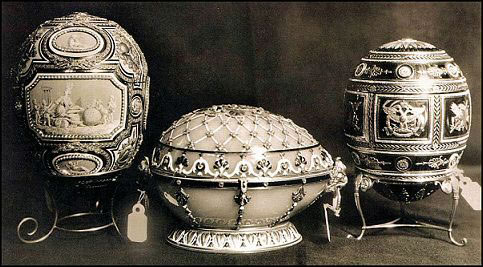
The 1914 Catherine the Great Egg, the 1894 Renaissance Egg and the 1912 Napoleonic Egg photographed in Moscow in the 1930's before they were sold abroad. Courtesy Fabergé Research Newsletter, April 2017.
A new (June 2018) publication, Fabergé Rediscovered, published for the special exhibition with the same name, by Hillwood, Estate, Museum and Gardens, shows the beautiful Egg while open!

Fabergé Rediscovered, 2018 on Amazon.com
Page updated: January 10, 2019
